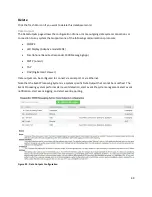
51
use a regular space character, but space characters are difficult to see when troubleshooting failed
system operation.
You can use blacklist and whitelist settings values to filter which Pager ID values are associated with the
output, allowing the output to only be delivered messages associated with the defined Pager ID values.
List values are always semi-colon delimited. Blacklist tells the system to NOT output messages
associated with the list of Pager ID values, while whitelist tells the system to output messages associated
with the list of Pager ID values. An example blacklist setting is blacklist=101;105. An example whitelist
setting is whitelist=102;103;104;200.
You can use a Settings parameter of sendcancel=0 for TAP, COMP2, and SMTP protocols, as a means of
suppressing the output of event cancellation detection notifications, for the selected Data Output. The
default behavior of specific Data Outputs is that event cancellation notifications are enabled unless
otherwise disabled via sendcancel=0.
Following is a list of Settings parameters available for use with Data Outputs, their range of values, and
their default behaviors:
•
baud=NNNN
, with valid values of 300, 1200, 2400 or 9600 (default 9600)
•
parity=XXXX
, with valid values of none or even (default none)
•
databits=N
, with valid values of 7 or 8 (default 8)
•
stopbits=N
, with valid values of 0 or 1 (default 1)
•
cancelprefix=XXXX
, example value of cancel{SP} (default cancel{SP})
•
cancelsuffix=XXXX
, example value of {SP}cancel (default blank)
•
blacklist=NNN;NNN…
, with NNN being any pager ID value delivered by the equipment
connected to the Data Input that the original data was collected on (default blank)
•
whitelist=NNN;NNN…
, with NNN being any pager ID value accepted by the equipment
connected to the Data Output (default blank)
•
sendcancel=N
, with valid values of 0 or 1 (default 1)
Protocol
The communications protocol used by the data output.
Delete
Allows you to delete this record.
Data Connections
The Data Connections page allows the configuration of one or more connections between Data Inputs
and Data Outputs, to tell the system how to perform the following types of functions:
•
Protocol conversion
















































